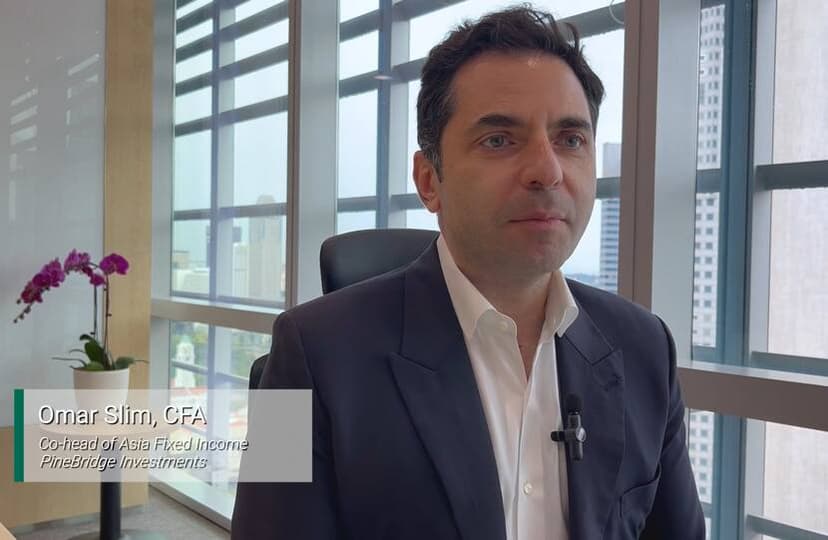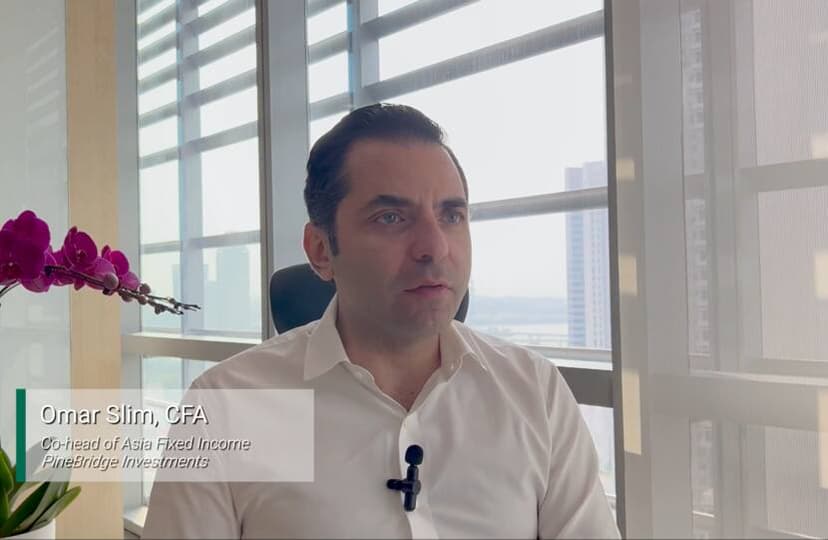2024 Asia ex Japan Fixed Income Outlook: Staying Selective Amid Compelling Alpha Opportunities

Omar Slim, CFA
Co-Head of Asia Fixed Income

Andy Suen, CFA, FRM
Co-Head of Asia Fixed Income
The broad Asian macro environment stands out globally: A relatively strong economic growth outlook, benign inflationary pressures, and potential policy easing on the horizon paint a positive picture. This should translate into generally stronger corporate balance sheets.
Despite weaker-than-expected Chinese economic growth in 2023, China will continue to offer robust economic growth in 2024, especially when compared to other major economies. We still expect certain Chinese economic segments to underwhelm, so selectivity will remain key.
We continue to have conviction in Asia US dollar investment grade bonds given historically higher risk-adjusted returns relative to global peers, in addition to their diversification benefits and income potential. Specifically, we see opportunities in a few areas in 2024, including Korean financials, some Indonesian quasi-sovereign issuers, Japanese and Australian financials and corporates, and several Indian and Southeast Asian issuers.
Beyond China property, we believe Asia high yield bonds offer compelling opportunities with their relatively higher yield levels and lower expected default rates. We expect attractive risk-adjusted reward particularly within sectors including recovery-related consumption, Indian renewables, and credit with strong liquidity positions and access to cheaper local funding.
We also see select opportunities within the Asian local currency markets. Relatively low inflationary pressure is likely to lead some Asian central banks to consider easing policy in 2024. This, coupled with peaked US dollar strength and stable fiscal metrics, should offer investors compelling allocation opportunities within onshore bonds.

For fixed income investors in search of some reprieve from significant interest rate hikes by most major central banks since mid-2022, we believe Asia presents a potentially attractive opportunity for portfolios.
First, Asia is appealing from a growth perspective. Despite China’s economic softening, the region is expected to grow by 4.6% in 2023, up from 3.9% in 2022, according to the latest International Monetary Fund (IMF) report.1 It is the only region in the world to see accelerating economic growth in 2023. Even though growth is projected to slow to 4.2% in 2024, the global economy by comparison is only forecast to muster 3% growth in 2023 and 2.9% in 2024.1
Another key factor fueling Asia’s broad appeal is central bank policy. Persistent inflation in developed market economies from the US to Europe to the UK may mean rate cuts are unlikely until the second half of 2024, if at all. The story in Asia is different, as most central banks have either completed or nearly completed their tightening efforts, and we expect monetary policy to pivot toward easing in 2024 in countries such as India, Indonesia, and the Philippines. Further, inflationary pressures have been milder in Asia than in the rest of the world, and have stayed within central bank target ranges in most countries. Except for one or two economies, including Korea and Japan, we expect no recessions in the region.
These dynamics should translate into healthier corporate fundamentals, as the economic environment remains healthy, with China remaining a focal point in Asia.
In 2023, Chinese economic growth is expected to be lower than what most economists anticipated at the beginning of the year. We were and remain more measured in our growth expectations, and we think growth in 2023 will be roughly around or marginally short of the 5% target. The main headline in our view is that Chinese growth has downshifted, a trend we do not expect to change anytime soon. In spite of this, we see two major market themes investors should watch. First, Chinese growth is still relatively robust, and policymakers have the tools to manage the downshift. Second, we expect certain economic segments in China to remain stressed. For instance, we do not expect that the property market will rebound in any major way. We also see some signs of weakness elsewhere, such as in certain local governments. As such, we expect policy measures will remain highly targeted to manage growth and avoid any systemic or contagion risks.
Key Convictions
1. Asia USD investment grade bonds remain a well-anchored, high-quality asset class.
Broadly, Asia USD investment grade (IG) bonds continue to provide compelling risk-adjusted returns relative to their global peers, with consistent outperformance over a 10-year timeframe as of 31 August 2023 (see chart below).
This asset class has been heavily tested over the past few years by both external shocks (unprecedented monetary policy hikes, for instance) as well as internal shocks (strict and lengthy Covid restrictions in Asia, which impacted growth). This segment of the market has remained well-anchored throughout those episodes, with lower drawdowns versus peers.
Asia USD Investment Grade Bonds Have Provided Compelling Risk-Adjusted Returns
10-Year Total Return History

Sources: Bloomberg. Rolling 10-year data as of August 2023. Asia USD Bonds represented by the JPM JACI index, Asia IG USD Bonds by JPM JACI Investment Grade, Emerging Markets (USD) by the JPM EMBI Global Diversified index, Emerging Markets IG (USD) by the JPM EMBI Global Diversified index Investment Grade, Emerging Markets IG Bonds (USD) by the JPM Corporate EMBI Diversified High Grade Index Level (USD), US IG and US IG (5-7yr) by BofA ICE index, US Inflation Linked by Bloomberg US Govt Inflation-Linked All Maturities Total Return Index, Europe IG by Bloomberg Pan European Aggregate Credit, Global Aggregate Credit IG (USD) by Bloomberg Global Agg Credit Total Return Index, Asia Local Currency by Bloomberg Asia Local Currency Index. Diversification does not insure against market loss. For illustration only. There is no assurance that the investment strategies and processes mentioned herein will be effective under all market conditions. Investors should evaluate their ability to invest for a long-term based on their individual risk profile especially during periods of downturn in the market. Past performance, or any prediction, projection, or forecast, is not indicative of future performance.
As a result, exposure to the asset class for portfolio diversification is attractive for global income portfolios. Other appealing features of Asia USD IG bonds include significantly lower interest rate risk given its shorter duration, which buffers rate volatility; and demand underpinned by local investors with a strong home bias, mitigating the volatility of the asset class.
The resilience of Asia USD IG bonds has also prevailed amid the negative headlines in China’s property sector. In reality, the impact on the Asia IG universe has been marginal – while China is the biggest issuer in the market, representing about 30%-40% of issuance (depending on the index used to proxy the market), property makes up less than 3%.
We continue to believe bond selectivity is a key performance differentiator, especially with the already-high levels of return dispersion across Asia USD IG bonds likely to continue. Specifically, we see opportunities in a few areas in 2024, including Korean financials, some Indonesian quasi-sovereign issuers, Japanese and Australian financials and corporates, and several Indian and Southeast Asian issuers.
Another consideration for investors in the asset class is the relatively low issuance level in Asia’s primary market. In particular, we expect the size of the region’s credit landscape to shrink in 2024 as maturities exceed new issuances by around two times.
Scarce Issuance Within Asia’s Credit Markets (ex Japan and Australia)

Source: Data as of 8 November 2023. JP Morgan, PineBridge Investments. Asia Credit Market represented by JP Morgan Asia Credit Index. For illustrative purposes only. Any opinions, projections, forecasts, or forward-looking statements presented are valid only as of the date indicated and are subject to change. We are not soliciting or recommending any action based on this material. Past performance, or any prediction, projection, or forecast, is not indicative of future performance.
2. Asia high yield offers attractive risk-reward potential, excluding the China property sector.
The prolonged downturn in China’s property sector over the past two years has triggered a remarkable shift in the composition of the Asia high yield (HY) universe. The China property sector has shrunk from around 35% of the Asia HY market in mid-2021 to less than 5% as of end-October 2023. As a result, the weightings of financials, consumers, and utilities have grown and now collectively account for around half of the index weight on aggregate.
China’s Property Sector Has Shrunk Significantly Since 2021
HY Sector Distribution

Source: JP Morgan as of 31 August 2023. Any opinions, projections, forecasts, or forward-looking statements presented are valid only as of the date indicated and are subject to change. For illustrative purposes only.
Within today’s Asia (ex China property) HY corporate space, historical default rates have been relatively lower than the US HY default rate, with a lower default rate year-to-date in 2023. We expect defaults to stay low on the back of the resilient macro backdrop as well as corporates’ ability to access alternative financing in local markets. We think the negative sentiment toward the asset class (as a result of defaults in the China property sector) have led to a number of attractive dislocation opportunities.
Asia (ex. China Property) Has Lower Default Rate Than US HY
US vs. Asia (ex. China Property) Historical Default Rate

Source: JP Morgan, PineBridge Investments. As of 31 August 2023. Any opinions, projections, forecasts, or forward-looking statements presented are valid only as of the date indicated and are subject to change. We are not soliciting or recommending any action based on this material. Past performance, or any prediction, projection or forecast, is not indicative of future performance.
In conjunction with higher yield levels both on an absolute and a comparative basis, we think this market offers pockets of value – and selection to express specific credit views will be key to potentially benefit ahead of a market recovery in Asia HY. With this in mind, we see several sectors within Asia HY that may offer alpha potential in 2024:
Beneficiaries of the ongoing reopening and recovery themes in the region, particularly in certain consumption-related sectors like gaming, retailers, shopping malls, airports, and TMT (technology, media, and telecom).
Beneficiaries of the drive toward decarbonization, especially Indian renewable energy.
Corporates across multiple sectors – particularly commodities – with strong liquidity positions as a result of strong operating cash flows and access to cheaper local funding sources.
We also believe there is still room to be highly selective in the China property sector by focusing on the very limited number of likely survivors, which have large rental property portfolios and land banks in top-tier cities.
There are several parts of the HY universe in Asia that we would avoid, including distressed China property names, local government financing vehicles in China, and credits that lack a financial buffer in light of the bumpy recovery in China, as well as corporates without reliable access to local funding channels and credits that have rich valuations relative to their fundamentals.
Staying focused
Ultimately, buoyed by Asia’s strong macro picture, the region’s credit fundamentals, especially in the highest-quality segment, remain strong.
As a result, investing in Asia USD investment grade and high yield bonds should enable investors to benefit from the portfolio diversification and reliable income opportunities that the region’s markets can offer.
As with all asset classes, following a disciplined credit fundamental research process will support these efforts to uncover multiple sources of potential alpha.
For more investing insights, access our 2024 Global Investment Outlook.
1Source: IMF, Regional Economic Outlook Asia and Pacific, October 2023. https://www.imf.org/en/Publications/REO/APAC/Issues/2023/09/27/regional-economic-outlook-for-asia-and-pacific-october-2023
Disclosure
Investing involves risk, including possible loss of principal. The information presented herein is for illustrative purposes only and should not be considered reflective of any particular security, strategy, or investment product. It represents a general assessment of the markets at a specific time and is not a guarantee of future performance results or market movement. This material does not constitute investment, financial, legal, tax, or other advice; investment research or a product of any research department; an offer to sell, or the solicitation of an offer to purchase any security or interest in a fund; or a recommendation for any investment product or strategy. PineBridge Investments is not soliciting or recommending any action based on information in this document. Any opinions, projections, or forward-looking statements expressed herein are solely those of the author, may differ from the views or opinions expressed by other areas of PineBridge Investments, and are only for general informational purposes as of the date indicated. Views may be based on third-party data that has not been independently verified. PineBridge Investments does not approve of or endorse any republication of this material. You are solely responsible for deciding whether any investment product or strategy is appropriate for you based upon your investment goals, financial situation and tolerance for risk.



